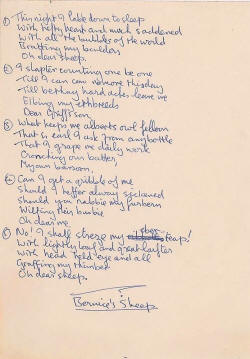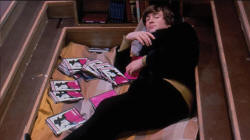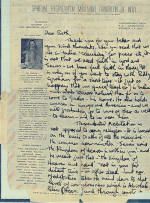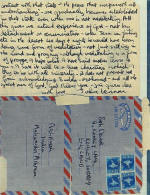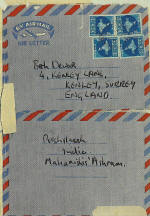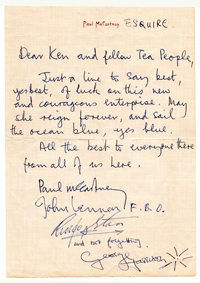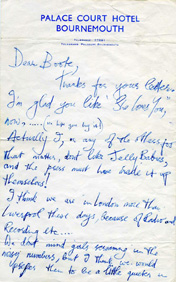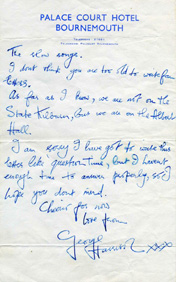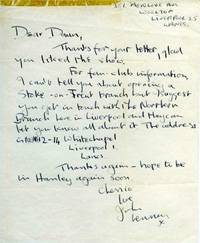
|
Handwritten Beatles material consists of anything that was scripted or printed by one or more members of the band with content above and beyond a simple signature with or without a short salutation. Quite simply this refers to notes, letters, memos, bylines, etc. In the early days, before they were a worldwide phenomenon, group members - particularly John, Paul and George would actually answer a quantity of fan mail delivered to them or even slid under their doors by adoring female fans. They would take the time to write short notes or letters in response, often signing with "love" and "X's". Handwritten correspondence was not limited to fan mail, however. Although the vast majority of the letters, notes and postcards were not originally intended to become collector's items because of their personal nature, sometimes the recipients of such material realized that there was a monetary value inherent and often the decision was made to place them on the market either through auction or private sale. The value of any item that is handwritten by a member of The Beatles is directly proportional to two factors: the content of the writing and the amount of writing. The content is the most important, especially if it contains any information about the history of The Beatles or a band member's state of mind during a particular period. For example, a John Lennon 4 page handwritten letter from Hamburg in 1961 to a friend discussing the grueling schedule of The Beatles and the fact that he might be discouraged about the group ever fulfilling his dreams and goals, would be a piece for the serious collector and would have a relative high dollar value. By comparison, a 2 line postcard written by John in the mid 1970's with minimal content would be more affordable for a collector who would simply like to own a piece of Lennon writing. All in all, Beatles handwritten material can be important and exciting to own as it is always a bit more personal than a signature, which, of course is far more abundant. Finally, handwritten material represents a very special intimate part of The Beatles lives that were seldom imparted to the public in any way. To acquire even one of these treasures is indeed quite an accomplishment for any fan or collector. HI32. A Stunning John Lennon Handwritten Manuscript For
Bernice's Sheep, Which Appears In His Book A Spaniard In The Works (click any image to view larger) SI30. A Rare Important And Revealing John Lennon Handwritten Letter, Written In Rishikesh, India While In The Midst Of Composing Most Of The Songs That Would Later Appear On “The White Album”. In February of 1968 The Beatles with their wives and girlfriends took a journey to an ashram in Rishikesh, India in search of spiritual enlightenment. Having recently been a key influence for and the leading figures of the magnificent and colorful ‘Summer of Love’ following the release of their masterpiece album “Sgt. Pepper’s Lonely Hearts Club Band”, The Beatles were on top of the world, but even so they knew that a change of some sort was needed. The band was invited to the ashram by the Maharishi Mahesh Yogi, who they had met with previously in August of 1967 in Bangor, Wales while attending a weekend seminar on Transcendental Meditation. That trip that was cut short by the sudden and unexpected death of the band’s manager Brian Epstein, a tragic event which left The Beatles now in even more of a need some answers. This all coincided with The Beatles denunciation of drug use in favor of Transcendental Meditation, so off to Rishikesh they went. While in India, John and George stayed the longest, with Ringo leaving after 10 days and Paul staying roughly 5 full weeks before heading home. In between marathon meditation sessions, long daytime walks, meals, group sing alongs and quite a bit of songwriting (Lennon said that he wrote 15 songs while in India – more than Paul and George combined), John took some time to answer a few letters he had received at the ashram. Of the few responses he sent out (mainly to friends), this one really stands out because of the content of the letter is absolutely incredible – it's unquestionably one of the best Lennon handwritten letters in existence. He goes into some detail about The Beatles purpose for going to India, religion – with John quoting Jesus and confirming his own personal obligation to Christianity, also talking about Transcendental Meditation as it relates to religion and through it how one can actually be 'experiencing God'. John writes in full, with the ‘we’ and ‘us’ references in the first paragraph relating to The Beatles: Dear Beth, Thank you for your letter and your kind thoughts. When you read that we are in India ‘searching’ for peace etc, it is not that we need faith in God and Jesus –we have faith them; It is only as if you went to stay with Billy Graham for a short time – it just so happens that our guru (‘teacher’) is Indian - and what is more natural than for us to come to India – his home. He also holds courses in Europe and America – and we will probably go to some of these as well – to learn – and to be near him. Transcendental Meditation is not opposed to any religion – it is based on the basic truths of all religions – the common denominator. Jesus said ‘the Kingdom of Heaven is at hand’ – not in some far distant time – or after death – but now. Meditation takes the mind down to that level of consciousness which is Absolute Bliss (Heaven) and through constant contact with that state – ‘the peace that surpasseth all understanding’ – one gradually becomes established in that state even when one is not meditating. All this gives one actual experience in God - not by detachment or renunciation – when Jesus was fasting etc in the desert 40 days & nights he would have been doing some form of meditation – not just sitting in the sand and praying – although meditating is a form or prayer. I hope what I have said makes sense to you – I sure it will to a true Christian – which I try to be with all sincerity – it does not prevent me from acknowledging Budda – Mohammed – and all the great men of God. God Bless You – jai guru dev. with love, John Lennon Ending with “jai guru dev”, the mantra that John sang repeatedly in his beautiful composition “Across The Universe”, the letter was written out by John in black fountain pen on one sheet of stationary for the Maharishi’s own "Spiritual Regeneration Movement Foundation Of India". The stationary sheet was made so that it folds down into its own envelope, which John hand addressed a fan (Beth Dewer, from Surrey not far from where John lived at the time) who wrote to him at the ashram expressing her concerns for The Beatles and their newfound interest in studying Transcendental Meditation under the Maharishi and how it would potentially clash severely with Christianity. The return address John wrote on the envelope was simply "Rishikesh India Maharishi's Ashram". There is a tear along the fold line on the bottom third of the page, otherwise in good condition. This spectacular handwritten Lennon letter will come with a Special Limited Edition copy of Paul Saltzman’s book “The Beatles In India”. Here is a link to see some of the fabulous pictures (all contained in the book) that Saltzman took while sharing time with The Beatles in Rishikesh in 1968. https://thebeatlesinindia.com/book/ https://thebeatlesinindia.com/photos/ Postmarked March 25, 1968, the letter is quite lengthy with a lot of writing done by John which is very detailed and revealing, written during a really key period in the history of The Beatles. The Beatles journey to India to study Transcendental Meditation and being there without any outside interruptions, phone calls or business related distractions was an extremely fertile situation for their songwriting, and while there meditating their songwriting blossomed in a way it never had before. This was in fact the band’s most productive period and without India, there absolutely would be no “White Album” as we know it. There aren’t many truly amazing John Lennon Beatle era handwritten letters out there and of those they rarely ever come to market, as most are tucked away in collections and unavailable. This letter and certainly is one of best of them, ranking way up there with the ‘cream of the crop’ for content, length of writing, and the time frame during which it was written as it relates to what was happening at that moment. Here is a rare chance to own and extremely scarce piece of John Lennon’s handwritten thoughts about Transcendental Meditation and religion, with several references to Jesus and God…..$75,000
(click any image to view larger) SI22. A Handwritten Letter Signed By All 4 Beatles While On The 1966 U.S.
Tour The London-born Ken Douglas had migrated to the United States in 1964 on the heels of the British Invasion, having been exposed to America through his earlier career as the athletic director on a cruise ship. From New York, he traveled to Louisville to visit friends and met up with a man who had a men's clothing store that happened to be across the street from WKLO. Douglas got a job at the clothier and in 1965, through the store's proximity to the radio station, had a chance encounter with program director Mitch Michael. Michael invited him to the station, gave him a tour, introduced him to the staff and, seeing the potential in having a Brit on the air, asked him if he'd like to sit in with one of his deejays and talk about London life, fashion and music. Douglas did the gig for about two months, and was soon offered his own show. For "The Ken Douglas Show", he would make frequent trips to London to interview all the top British stars, and before long, he was the top jock at WKLO. By early 1966, the much in-demand Douglas had his own fan club with a devout following of over 1,400 members. An encounter with Beatles press officer Tony Barrow led to a meeting with Brian Epstein, who told him that the next time the Beatles toured America, he'd be invited to join them. For the first half of the 1966 North American Tour, Douglas was at their side, in hotels, on the plane, on buses and backstage before the shows. His reports from the tour helped place WKLO at the top of the ratings heap in Louisville. The Beatles found Douglas someone they could easily relate to - a fellow countryman. In Cleveland on August 14, 1966, Douglas sat down with Ringo Starr, who told him about his home life and fatherhood. Douglas also reported on the chaotic scenes at Cleveland Stadium. Two days later, on August 16th in Philadelphia, Douglas snared Paul McCartney for a lengthy recorded chat. When Douglas brought up the diminishing crowds at Beatles concerts, McCartney was quick to remind him that the Beatles still played to more people than any other act. Douglas predicted that the Beatles would continue to sell records long after they stopped touring, which led McCartney to reveal that the group was far more interested in writing and recording than performing, citing the band's increasing inability to be heard above the screams. Of course, history has shown that, two weeks later, their touring days would indeed end. McCartney then spoke with Douglas about his life in London (having just bought a home near the EMI Studios), the Beatles' recording schedule after the tour, the trip he took to Paris with John for the latter's 21st birthday and the mayhem in Cleveland, commenting that he enjoyed "fan participation" as long as no one got hurt. Finally, referring to the negative publicity generated by Lennon's "Bigger Than Jesus" statement, McCartney told Douglas that when there was no good news to report, the papers preferred disparaging articles. The pair got on well together. Within five
days of Douglas' interview with McCartney, the Beatles' bassist had written him
a letter, which was on Paul’s personal linen stationary. It read: Just a line to say best, yes best, of luck on this new and courageous enterprise. May she reign forever, and sail the ocean blue, yes blue. All the best to everyone there from all of us here." McCartney then signed his full name, followed by the other three Beatles - John Lennon (who has added "F.B.O." following his signature), Ringo Starr and finally, George Harrison, who has written “and not forgetting” before his signature, and a star-burst symbol afterwards. The “J” used by John is a ‘throwback’ to the style of “J” that was last seen in early 1963 – some 3 ½ years prior. All four of the signatures on this letter are perfect; they are excellent and complete examples, and are as nicely as they could have signed on that day. Additionally, McCartney has written “ESQUIRE” following his printed name in the letterhead. The included, original mailing envelope is also fully-addressed in Paul’s hand on the front: To
This envelope is postmarked from Cincinnati, Ohio on August 21, 1966, the exact mid-point of the tour. Affixed is the required 5 cent postage, in the form of a blue tinted George Washington stamp. On the reverse are the printed words "J.P. McCartney, London, England", the font being an exact match to that on the stationary – therefore making this the proper accompanying envelope! "Tea Time" refers to the frequent tea breaks that Douglas would take on the air with students visiting the station. While the content of the letter is subject to interpretation at this point in history, the "new and courageous enterprise" that McCartney writes about could refer to Douglas' possible return to the men's haberdashery business, which had been his occupation prior to his stint at WKLO. After leaving the station in 1969, he worked briefly at WINN and WAKY in Louisville and then moved to California where he did return to the men's clothing business, this time in a partnership with his close friend Davy Jones of the Monkees. This letter could allude to an earlier possible venture in men's apparel, which indeed would happen, but not for several years after. Handwritten letters signed by all four members of the Beatles are exceedingly scarce, with less than a handful surfacing to date. Add to that the fact that the vast majority of known (single signed) personal letters from any member of The Beatles was written in their early days, through 1963. Anything handwritten from the mid-1960s, especially while on tour in North America, is exponentially much more scarcer. This is by far the best of the few letters signed by all of The Beatles known to exist, making this an extremely rare opportunity for the discerning collector….. $30,000
SI4. A Letter Written By John Lennon To A Fan In Early 1963 This letter was fully handwritten by John Lennon in black fountain pen on a sheet of stationary paper which measures 8” x 10”. He starts off by writing his return address in the upper right hand corner: “251 MENLOVE AVE WOOLTON LIVERPOOL 25 LANCS” (Lancashire). This, of course, is "Mendips", the childhood home where he lived with his Aunt Mimi from 1945 until 1963, when The Beatles' growing fame necessitated a move to London.
The letter reads: Hanley was one of six towns that comprised Stoke-on-Trent and The Beatles played there only twice in their career -- on March 3, 1963 (the final night of the Helen Shapiro tour, during which The Beatles were an opening act for a 16 year old girl) and again on May 19, 1963 (the second night of their tour with Roy Orbison). This letter, in response to one the fan had written to John following the March show in Hanley, as the signature dates from early March of 1963. (By May, just two months later, characteristics within John’s signature had changed noticeably). On March 5th, just two days after that first Hanley gig, the band recorded their third single "From Me To You/Thank You Girl" and on March 22nd, their first LP "Please Please Me" was released. By the time they returned to Hanley with Orbison in May, The Beatles were so enormously popular that they would soon grab the spotlight from the American headliner, taking top billing on the tour. They had already come a long way in just two months. This letter represents one of the very few times that Lennon personally answered fan mail with a handwritten letter and it is certainly one of the last times he ever wrote to anyone from "Mendips" before his move to London. Once he took up residence in the city, the demands on his time grew exponentially and he rarely had the time for long personal replies like this one. The charm of this letter lies not only in the fact that it was written from his childhood home, but that he takes the time to personally direct a fan to the proper source for Beatles fan club information. Naturally he provides her with the address for Brian Epstein's NEMS store on Whitechapel Street in Liverpool, which at the time was the "Eppy-center" of the Beatle universe! Shortly thereafter, The Official Beatles Fan Club would be located on Monmouth Street in London. The letter is in very good condition, with non detracting mailing fold marks, tape residue at top left and a small tear to the right of this residue. Letters handwritten by John Lennon are extremely desirable and few are offered for sale in any given year. This is a truly rare opportunity to own a letter written by John just prior to The Beatles' quick astronomical rise to an unprecedented level of fame, which began right after this letter was written, following the release of their first LP record “Please Please Me”.....$19,500 |
|
Please email to contact us about any items you are interested in. We always enjoy talking to our long time veteran collectors and meeting new ones. |
|
All Rights Reserved; Frank Caiazzo, Beatles Autographs
602 Higgins Avenue, Suite 121, Brielle, NJ 08730, USA
